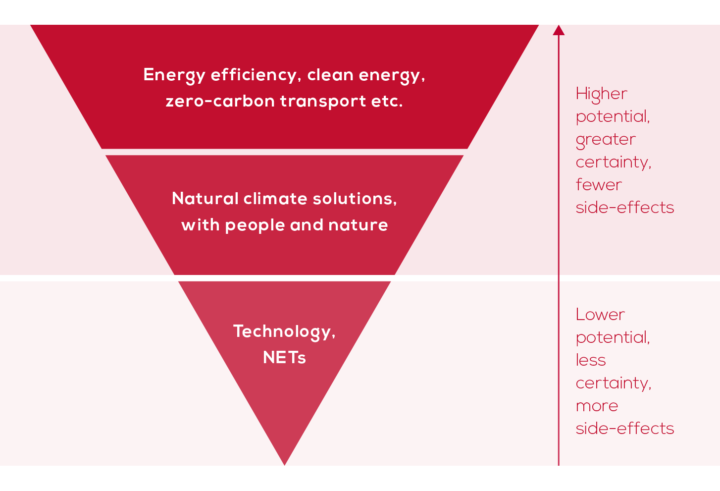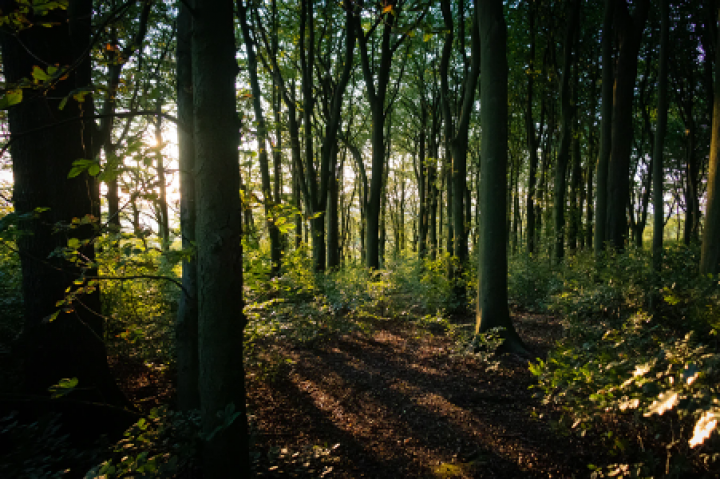Negative emissions: why, what, how?
What are so-called 'negative emissions', and why are they needed to reach net zero?

By Dr Simon Cran-McGreehin
@SimonCMcGShare
Last updated:
Why ‘negative emissions’?
In order to stabilise global warming at any level, emissions of carbon dioxide, the main greenhouse gas, need to be eliminated; reducing them is not enough. Other greenhouse gases such as methane also need to be constrained.

However, in sectors such as agriculture and aviation, bringing emissions to zero may not be possible. Therefore, the only approach is to draw sufficient greenhouse gases from the atmosphere to balance out emissions that remain – so that emissions reach ‘net zero’.
If negative emissions and positive emissions are balanced, global warming should stabilise. Currently the only greenhouse gas for which negative emissions are feasible at scale is carbon dioxide.
How much is needed, and when?
The Intergovernmental Panel on Climate Change (IPCC) published a landmark report in 2018 setting out what governments need to do if they are to fulfil the Paris Agreement. The IPCC said that meeting the 1.5ºC target implies reaching net zero CO2 emissions globally around mid-century, together with major reductions in other greenhouse gases, and that negative emissions will almost certainly be needed.
How much is needed will depend on how much progress is made in cutting emissions. It will also depend on whether warming releases more greenhouse gases into the air, for example by freeing methane trapped in permafrost.
Recent studies conclude that about around 17 billion tonnes of carbon dioxide (GtCO2) might need to be sucked from the air each year by mid-century in order to keep global warming below the previously agreed target of 2ºC. Greater amounts are likely to be required for 1.5ºC. For comparison, current global greenhouse gas emissions are equivalent to around 40 GtCO2.
What are ‘natural climate solutions’?
The best-known approach is to plant forests. Trees absorb CO2 from the air as they grow – so, broadly, a greater number of trees will absorb more CO2 from the atmosphere.

Other approaches include:
- restoring peat bogs
- restoring coastal ecosystems, increasing shoreline and marine plants.
There is also significant potential to safeguard carbon that is already in plants and the soil, by:
- avoiding destruction of forests, peat and shoreline ecosystems
- adopting ‘no-till’ agriculture, which avoids carbon release through soil disturbance
- better wildfire management to avoid burning of trees and plants.
The Government has recognised that the UK agriculture industry has a valuable role to play in natural climate solutions. There are proposals to cement this relationship in the new UK Agriculture Bill that offers financial incentives for farmers to reserve farmland for tree planting and wildlife. The Government is also set to release its Peat Strategy for England soon.
Technologies
In recent years, there’s been a lot of talk – and Government investment – into carbon capture, usage and storage, or CCUS.
One potential NET is bioenergy with carbon capture and storage (BECCS), in which plant material is burned to generate electricity and the CO2 produced is captured and stored underground. More plants are then grown, absorbing CO2 from the air – this is burned, taking more CO2 underground; and so on.
Another NET is direct air capture (DAC), where a chemical process extracts CO2 from the air. This process is challenging, and uses a lot of energy, as CO2 is in low concentrations in the atmosphere, compared with exhausts from power stations and factories.
There are a handful of DAC plants across Europe built by the Swiss firm Climeworks. As DAC technology becomes more mature, prices are likely to fall. Climeworks believe that costs of extracting a ton of carbon dioxide could fall from $1,000 to $100 within a decade.
There are also some ‘hybrid’ concepts, which enhance natural processes of carbon dioxide absorption using technology:
- boosting the growth of phytoplankton, tiny plants in the ocean, using iron filings (‘iron fertilisation’)
- creating biochar – charcoal – through pyrolysis (heating) of plant material. Spread on fields, biochar takes carbon into the soil in a stable form
- enhancing weathering of rock, a process that naturally carries CO2 into the ocean.
While technically possible, these options are ‘more uncertain’ and likely need further development before being modelled in net zero scenarios.
Technologies that would cool the Earth by reflecting or blocking incoming solar energy, such as putting dust into the atmosphere, are not NETs – they do not absorb CO2 and do not tackle ocean acidification.
How much can negative emissions be used?
Globally, natural climate solutions could in principle absorb about 28 GtCO2 per year by 2030. However, factors including competition for land might make the obtainable value much smaller. In the UK, the CCC estimate that around 60Mt CO2 could be captured in the UK each year by 2050 from engineered removal technologies.
The future of NETs is quite uncertain as the technology still needs to be developed and deployed at scale to understand what its costs will be, but the CCC has highlighted that their modelling scenarios ‘aim to reduce emissions where decarbonisation solutions exist, and minimise the need for removals.’

Natural climate solutions are faster to implement than NETs, but would be ‘saturated’ over time - for example, forests cannot be planted indefinitely. Planting new forests could conflict with other requirements for land such as growing food; but it could also provide habitat for nature. Mixed forest, which is generally good for biodiversity, absorbs more CO2 than monoculture.
Deployment of BECCS would also be limited by availability of land. Growing energy crops sufficient for negative emissions of around 12GtCO2 (the scale needed to limit warming to 1.5°C) could take up 25-85% of current global cropland (0.4-12bn hectares).
BECCS could also do more harm than good – contributing positive emissions – if intact forests were removed to make land for energy crops as there is uncertainty over the ‘supply chain emissions’ of pellets used in BECCS. There could also be competition for land between NCS, BECCS and crop growth for biofuels.
Natural solutions are likely to be cheaper than BECCS, where costs can vary greatly between $15-400 per tonne of carbon sequestered. For comparison, the EU carbon price has stood at less than €15 per tonne for most of its existence, although it has been rising since 2018, reaching a new high of €39 recently.
In the UK
The Climate Change Committee has calculated that achieving net zero via a ‘balanced’ pathway would need engineered negative emissions of around 60MtCO2 per year and nature-based sinks of 39MtCO2 per year. However, other scenarios see different scales of removals required.
For comparison, one recent estimate put UK potential for natural negative emissions at 96 MtCO2 per year, with around a half – 40 MtCO2 per year – deliverable at under $100 per tonne. The Government has proposed a Tree Strategy for England, with an aim to plant 30,000 hectares of trees per year across the UK by 2025 and restore peatlands. This could support the estimated 39Mt of CO2 removals that is estimated to be needed in 2050.
The UK’s BECCS capacity has also been estimated at around 62 million tonnes of CO2 per year, although this may require biomass imports and could be less if only British-sourced biomass is used. Drax power station has been involved in BECCS since the White Rose project in the early 2000s, and in autumn 2020 started a pilot with Mitsubishi Heavy Industries.
Share
